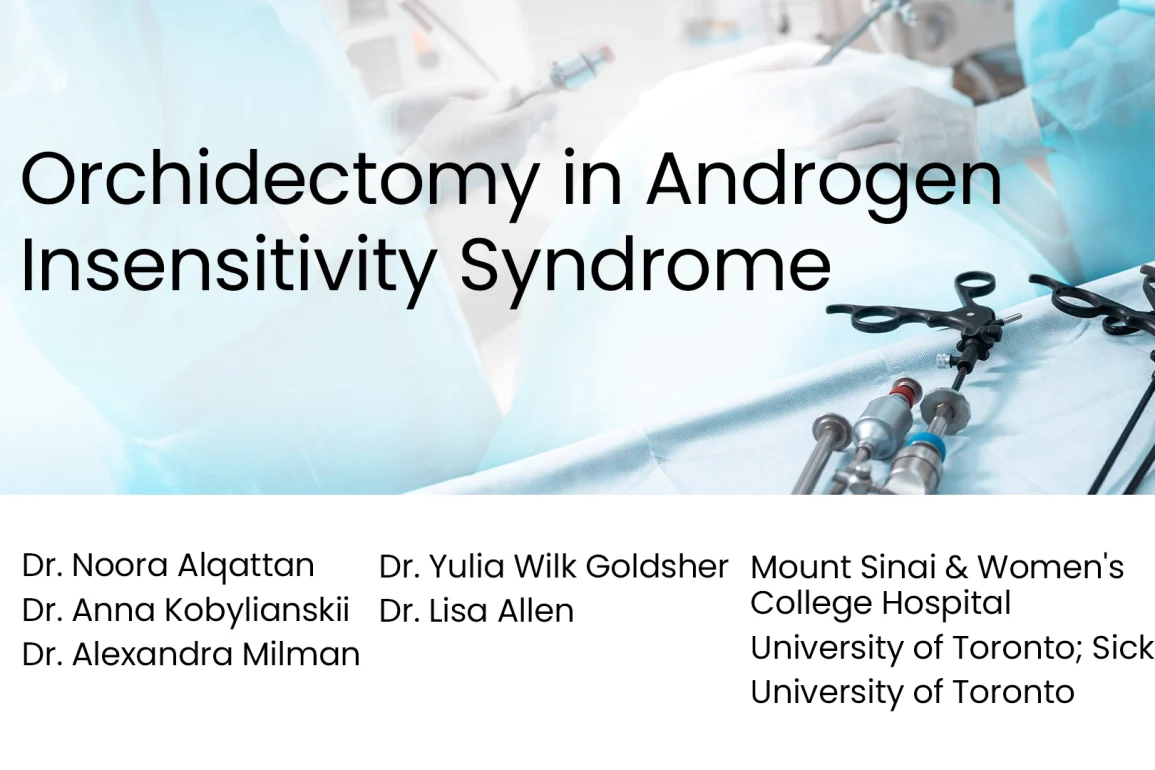Table of Contents
- Procedure Summary
- Authors
- Youtube Video
- What is Orchidectomy in Androgen Insensitivity Syndrome?
- What are the Risks of Orchidectomy in Androgen Insensitivity Syndrome?
- Video Transcript
Video Description
This video will discuss the clinical presentation of androgen insensitivity syndrome highlighting the different options of gonadal management in these cases which include gonadectomy followed by hormone replacement therapy, surveillance and gonadal transposition which facilitate monitoring. It will also demonstrate the principles of laparoscopic bilateral orchidectomy in these cases with a video demonstrating the steps.
Presented By
Affiliations
Mount Sinai & Woman’s College Hospital
University of Toronto, Sickkids
University of Toronto
Watch on YouTube
Click here to watch this video on YouTube.
What is Orchidectomy in Androgen Insensitivity Syndrome?
What are the Risks of Orchidectomy in Androgen Insensitivity Syndrome?
Video Transcript: Orchidectomy in Androgen Insensitivity Syndrome
This video will discuss orchidectomy in the management of individuals with complete androgen insensitivity syndrome. We will discuss the clinical presentation and management of complete AIS, review a case presentation of an individual who chose orchidectomy, and demonstrate the principles of laparoscopic bilateral orchidectomy in complete AIS.
AIS is an X-linked genetic disorder and the most common XY disorder of sex development with an incidence of one in 13,000 to 50,000. The main aetiology is a mutation in the androgen receptor gene leading to resistance to androgens. There are three possible phenotypes, complete, partial, or mild AIS. In this video we will focus on complete AIS.
As a reminder, in normal male foetal sex differentiation, the androgen receptor is necessary for both Wolffian duct differentiation into the epididymis, vas deferens, and seminal vesicles and for dihydrotestosterone to induce virilisation of the external genitalia. Anti-Müllerian hormone secreted by Sertoli cells bind to the anti-Müllerian hormone receptor, leading to Müllerian duct regression.
Individuals with CAIS have a karyotype of XY. The bipotential gonads differentiate into testes, which produce both androgens and MIS. However, due to the defect in the androgen receptor, there is no androgen effect. They may present antenatally or at birth with a discrepancy between their XY karyotype and their female genitalia, at puberty with primary amenorrhoea, or any time with palpable inguinal or labial testes.
Gonad management options include gonadectomy and subsequent hormone replacement therapy, surveillance, or gonadal transposition to facilitate monitoring.
Gonadectomy has been performed due to the risk of malignancy. While it increases with age, recent literature suggests a lower risk compared to previous, with a pre-malignancy rate of 6% at surgery and a malignancy rate of 1% to 2%.
Surveillance is done by annual imaging from puberty, either by ultrasound or MRI, depending on the location of the gonads.
Gonadal transposition involves surgically moving and fixing the intra-abdominal gonads either to the abdominal wall or in the inguinal area to allow for palpation and better visualisation by imaging.
Our case involves a 35-year-old diagnosed with CAIS by genetic information at the age of 29 when she was trying to conceive. Her older sister was also diagnosed with CAIS. Her left testes was palpable. The right was not. Options were discussed with the patient. As the patient was concerned regarding the malignancy risk, she opted to have gonadectomy.
Gonadectomy can be performed either through an inguinal incision or laparoscopically. The steps of the procedure are anatomic survey followed by mobilisation of the testes from the inguinal canal, division of the gubernaculum, ligation of the gonadal vessels, and specimen removal, followed by hernia repair if required.
The first step is anatomic survey. As you can see, the pelvis has no internal Müllerian structures. The right testes is visualised attached to the internal inguinal ring. The gonads are supplied by the gonadal vessels highlighted in red. On the left side of the pelvis, the left testes, gonadal vessels, and the external iliac artery are highlighted.
The left gonad is dissected through a plane that was made in the posterior peritoneum around the gonads, away from the other retroperitoneal structures. It is important to determine the location and the course of retroperitoneal structures, such as the ureters and the iliac vessels, to avoid iatrogenic injury.
The next step is to ligate the gubernaculum in order to separate the testes from the internal inguinal ring. The gubernaculum is fulcrated and divided using a vessel-sealing device as demonstrated in the video. The gonadal vessels were then identified, sealed, and divided, taking care to leave a pedicle.
The same steps were followed and repeated for the right testes. We started by mobilising the testes, followed by ligation of the gubernaculum, with the last step being ligation of the gonadal vessels.
The specimens were then removed from the abdomen. The patient’s post-operative course was unremarkable. She was treated post-operatively with oestradiol for hormone replacement therapy.
This video has outlined the steps of orchidectomy. It is important for care providers of individuals with CAIS to participate in shared decision-making regarding the management of the testes. Recent literature supports a lower-than-previous risk of testicular malignancy. However, there persists an elevated risk compared to CAIS-gendered [?] males with descended testes. If orchidectomy is chosen, a laparoscopic approach is feasible, even in the presence of inguinal testes.




